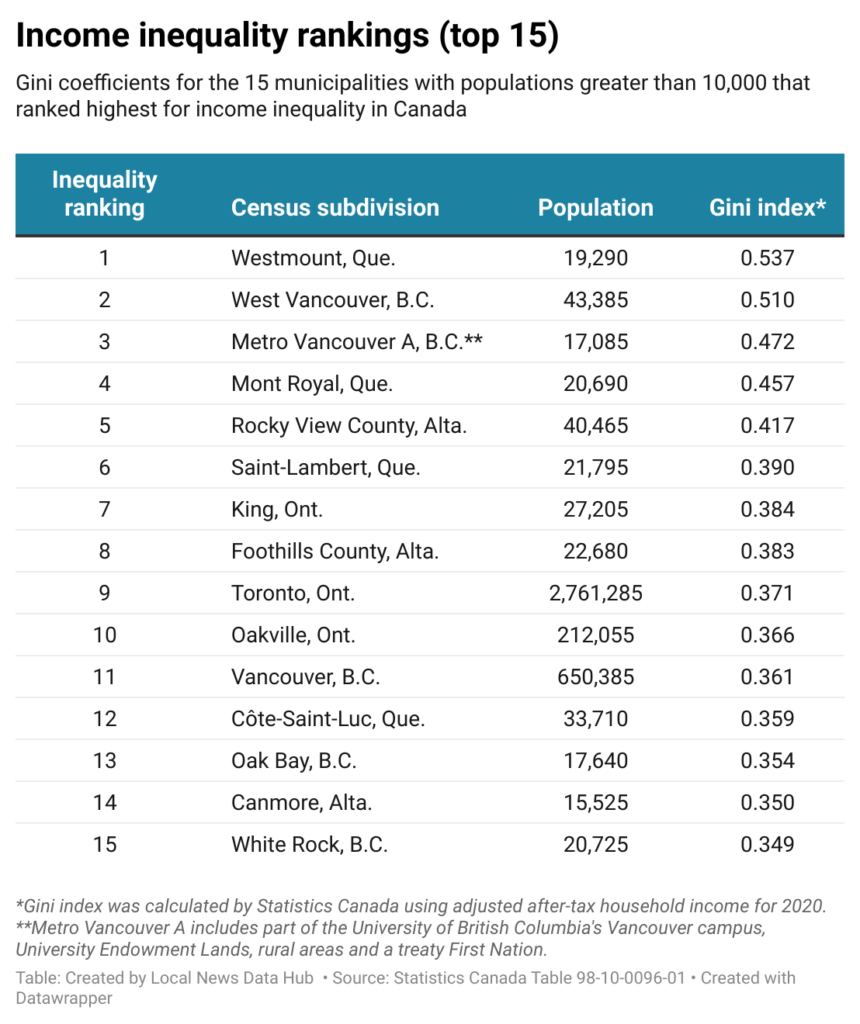
Income inequality creates divisions in many of Canada’s biggest cities, new analysis finds
Exceptions are Winnipeg and some commuter cities like Brampton, Ont., and Surrey, B.C.

By Carly Penrose
Local News Data Hub
Sept. 21, 2023
Income inequality, known for its corrosive effects on health, happiness and community ties, is much worse in some large Canadian cities than others, according to a new analysis of Statistics Canada data.
While Vancouver, Toronto and Calgary have significant levels of household income inequality, the gaps between higher- and lower-earning residents in Brampton, Ont., Surrey, B.C., and Winnipeg are much less pronounced, according to the ranking assembled by the Local News Data Hub at Toronto Metropolitan University.
In Oakville, Ont., another of the country’s most unequal places, the consequences of being poor are very real for Gloria Priest, who has lived on both sides of the income divide in the community of 213,000 just southwest of Toronto.
Priest said she was well-to-do until she got divorced. Then her household income fell below the poverty line and she moved to a different neighbourhood.
Now on the rare occasion when she sees people from her former life, some are kind, some don’t recognize her, and others “make that sniffly look, like I’m unpleasant,” Priest said.
In places like Oakville, which ranked 10th in Canada for income inequality, residents “become socially isolated among people like themselves,” said Ivan Townshend, a social geographer at the University of Lethbridge.
People of different means have fewer opportunities to cross paths when neighbourhoods separate those who “have” from those who “have not,” Townshend said. The isolation can make it easier for rich and poor to form ideas about each other based on stereotypes and then blame the other group for social ills, he added.
Income inequality has been linked to a reduced sense of community belonging, greater distrust among residents, more financial worries and increased anxiety about social status — outcomes all associated with lower levels of happiness and poorer mental and physical health. Research has also associated big income gaps with greater political polarization and increases in theft and vandalism fuelled by desperation and a sense of unfairness.
Howard Ramos, a sociology professor at Western University, said income disparities tend to be worse in economic hubs like Toronto, Vancouver and Calgary because they typically have more high-paid jobs and higher-than-average poverty rates.
Cities like Winnipeg or Halifax, he said, “are going to have less of those Bay Street workers and high earners, so there will still be some very wealthy people, but the accumulation or clustering will be less (significant).”
Fast-growing places like Brampton, Ont., a suburban municipality of more than 650,000 west of Toronto, also tend to be more equal, Ramos said.
The highest-earning 10 per cent of Brampton households, for instance, make three times more than the lowest earning households. In more unequal cities like Toronto and Oakville, the top earning group makes nearly five times more.
To compare income inequality across Canada, the Local News Data Hub ranked the country’s 418 municipalities with more than 10,000 people using Statistics Canada’s 2020 Gini index for adjusted after-tax household income.
The Gini index is an internationally recognized tool statisticians use to measure how income is distributed across a society. Income, in this case, takes into account wages, pension income, investment earnings such as dividends and interest, and government transfers like social assistance. The number 1 ranked municipality had the highest level of inequality.
The national ranking, which was reviewed by Statistics Canada senior research analyst Xuelin Zhang, points to significant variations among communities. For instance:
- Cities with more than 200,000 people that ranked high for inequality included Toronto, which was ninth on the overall Gini list, Vancouver, in 11th place, Calgary, in 22nd place, and Montreal, which was 29th.
- Brampton, ranked 374th, stood out among larger cities for having the least variation between higher- and lower-income earners. Other major population centres where income gaps were narrower included Surrey, B.C., ranked 180th, and Winnipeg, which placed 87th.
- St. John’s, N.L., ranked first for income inequality in the Atlantic provinces and 28th nationally.
- The widest gap between high- and low-income residents in Canada was in the much smaller city of Westmount, Que., home to about 20,000 people. In Westmount’s richest neighbourhood the median household income is $360,000, according to data from the non-profit Centraide Montreal. The municipality, however, also includes people who live in extremely low-income neighbourhoods on its periphery. The highest-earning 10 per cent of households in Westmount made nearly 11 times more than the lowest earners in 2020.
- West Vancouver, B.C., which has a population of just under 45,000, was second in the Gini ranking. While the income data indicates a significant number of low-income people live in West Vancouver, some researchers suggest many of them may be quite well-to-do, with income from overseas, savings or inherited wealth and non-financial assets like real estate.

Data and statistical rankings, however, don’t capture the day-to-day experiences of people who live in places with big gaps between high- and low-income residents.
Aimee Benoit, a University of Lethbridge alumna who studied the impact of income inequality on Calgary neighbourhoods as part of her PhD dissertation, said some residents she interviewed in the city’s low-income pockets told her they felt unwelcome in wealthier and more gentrified areas like gated communities and golf courses.
Many felt a sort of stigma as they were “excluded from community activities based on where they lived,” said Benoit, who is now a community heritage expert at Athabasca University.
Statistics Canada data show income inequality declined nationally between 2015 and 2020, largely due to the Canada Child Benefit introduced in 2016 and pandemic-related government transfers like the Canada Emergency Response Benefit (CERB). But David Macdonald, an economist at the Canadian Centre for Policy Alternatives in Ottawa, said inequality and poverty are expected to rise now that CERB payments have ended.
Macdonald also pointed out that the Gini measure tends to underestimate inequality because it is calculated based only on income data and doesn’t include inherited wealth, capital gains or non-financial assets like real estate. “If you include capital gains in the definition of income,” he added, “then you actually see income inequality grow.”
A recent Statistics Canada report illustrated Macdonald’s point. The wealthiest 20 per cent of households controlled two-thirds of the country’s net worth as of early 2023, the report says, while the bottom 40 per cent accounted for just 2.7 per cent. The report also noted that the wealth gap between rich and poor in Canada widened at the fastest pace on record in the first quarter of this year. Compared to the wealthiest households, lower-income Canadians accumulated more debt, saw their savings shrink and received less investment income.
Social justice advocates say there are many ways to reduce income inequality. Bridget Clarke, the advocacy co-ordinator at the St. John’s Status of Women Council in Newfoundland and Labrador, said stronger pay equity legislation would help.
Labour organizations argue for increases in social assistance, a higher minimum wage and updated labour laws that reduce the number of precarious jobs and make it easier for workers to unionize.
Last year, Halifax Regional Council and the Union of BC Municipalities both passed resolutions calling for a federally funded guaranteed basic income.
This story was produced by the Local News Data Hub, a project of the Local News Research Project at Toronto Metropolitan University’s School of Journalism. The Canadian Press is the Data Hub’s operational partner. Detailed information on the data and methodology can be found here.